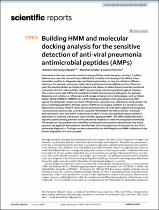| dc.contributor.author | Bakare, Olalekan Olanrewaju | |
| dc.contributor.author | Keyster, Marshall | |
| dc.contributor.author | Pretorius, Ashley | |
| dc.date.accessioned | 2022-08-01T09:54:49Z | |
| dc.date.available | 2022-08-01T09:54:49Z | |
| dc.date.issued | 2021 | |
| dc.identifier.citation | Bakare, O. O., Keyster, M., & Pretorius, A. (2021). Building HMM and molecular docking analysis for the sensitive detection of anti-viral pneumonia antimicrobial peptides (AMPs). Scientific Reports, 11(1) doi:10.1038/s41598-021-00223-8 | en_US |
| dc.identifier.issn | 20452322 | |
| dc.identifier.uri | 10.1038/s41598-021-00223-8 | |
| dc.identifier.uri | http://hdl.handle.net/10566/7648 | |
| dc.description.abstract | Pneumonia is the main reason for mortality among children under five years, causing 1.6 million deaths every year; late research has exhibited that mortality is increasing in the elderly. A few biomarkers used for its diagnosis need specificity and precision, as they are related to different infections, for example, pulmonary tuberculosis and Human Immunodeficiency Virus. There is a quest for new biomarkers worldwide to diagnose the disease to defeat these previously mentioned constraints. Antimicrobial peptides (AMPs) are promising indicative specialists against infection. This research work used AMPs as biomarkers to detect viral pneumonia pathogens, for example, Respiratory syncytial virus, Influenza A and B viruses utilizing in silico technologies, such as Hidden Markov Model (HMMER). HMMER was used to distinguish putative anti-viral pneumonia AMPs against the recognized receptor proteins of Respiratory syncytial virus, Influenza A, and B viruses. The physicochemical parameters of these putative AMPs were analyzed, and their 3-D structures were determined utilizing I-TASSER. Molecular docking interaction of these AMPs against the recognized viral pneumonia proteins was carried out using the PATCHDOCK and HDock servers. The results demonstrated 27 anti-viral AMPs ranked based on their E values with significant physicochemical parameters in similarity with known experimentally approved AMPs. The AMPs additionally had a high anticipated binding potential to the pneumonia receptors of these microorganisms sensitively. The tendency of the putative anti-viral AMPs to bind pneumonia proteins showed that they would be promising applicant biomarkers to identify these viral microorganisms in the point-of-care (POC) pneumonia diagnostics. The high precision observed for the AMPs legitimizes HMM’s utilization in the disease diagnostics’ discovery process | en_US |
| dc.language.iso | en | en_US |
| dc.publisher | Nature Research | en_US |
| dc.subject | Mortality | en_US |
| dc.subject | Pneumonia | en_US |
| dc.subject | Anti-viral pneumonia | en_US |
| dc.subject | Viral microorganisms | en_US |
| dc.title | Building HMM and molecular docking analysis for the sensitive detection of anti-viral pneumonia antimicrobial peptides (AMPs) | en_US |
| dc.type | Article | en_US |

